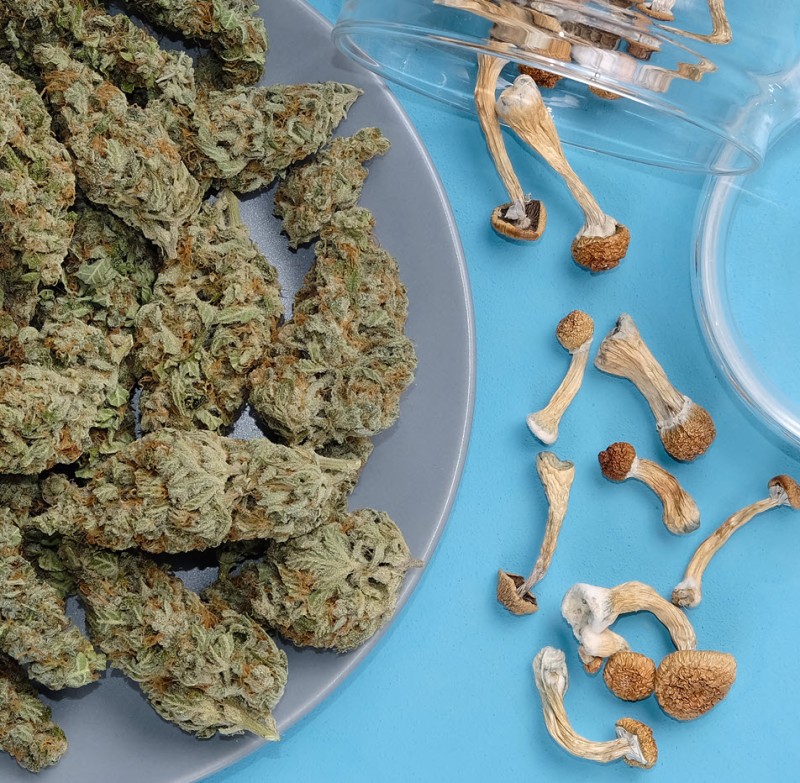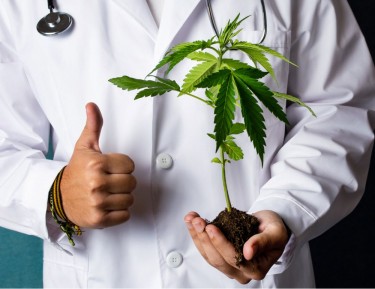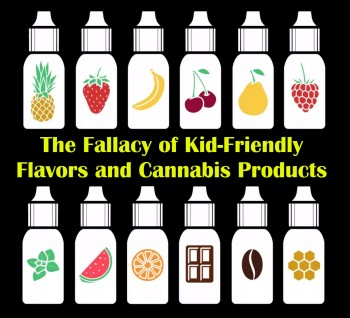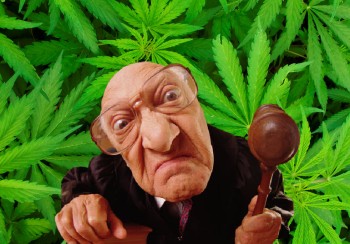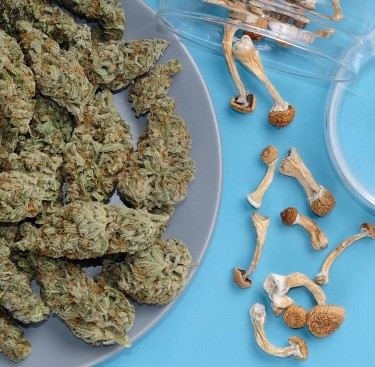
Researchers Aim To Combine Psilocybin and Cannabis Into Single Medical Treatment
According to a product patent from the renowned marijuana laboratory, CaaMTech, substantial strides have been made in developing a comprehensive treatment that combines cannabinoids and psilocybin for treating both physical and mental health concerns.
Located in Issaquah, Washington, less than 20 miles southeast of Seattle, CaaMTech is aggressively researching the interactions between these two chemicals as well as the potential effects on physical and mental health.
The initial stages of their enhanced psilocybin-cannabinoid product development are presently underway.
This patent advancement comes at a time when genetic data on cannabis and psilocybin is becoming more widely available, opening up possibilities for investigating novel ways these two substances might interact, potentially leading to the development of novel commercial products.
For instance, the use of cannabis and psilocybin together has shown to be effective in shrinking tumors in patients with breast cancer, as was the case in the case of a 49-year-old woman.
Researchers concluded as a result of this discovery that there is growing anecdotal and empirical evidence that supports the therapeutic effects of cannabinoids and psychedelics in preventing the growth of tumors and acting as palliative medicine to ease the pain and emotional distress brought on by cancer and chemotherapy.
Incorporating psilocybin with a minor cannabinoid like cannabichromene (CBC), abundant in the cannabis plant, may help researchers create a comprehensive treatment for inflammation and severe mental health issues.
The president and CEO of the Canadian cannabis business Hexo Corp., Charlie Bowman, reaffirmed the viability of this strategy by saying, "That most certainly can be done." He added that while CBC is difficult to produce and expensive to synthesise, it may be combined with psilocybin mushrooms to provide a more cost-effective alternative to a broader spectrum of clients. Making a water-soluble version of CBC and mixing it with mushrooms could result in one possible way to consume it: as tea.
Cannabis-assisted psychedelic treatment is currently being used at the Center for Medicinal Mindfulness in Boulder, Colorado. It is run by Daniel McQueen, author of "Psychedelic Cannabis" and executive director. This entails facilitating private cannabis and ketamine psychedelic experiences under medical supervision, including classes, personalised coaching, guided meditation sessions, and community support.
McQueen concurred that creating a psilocybin-cannabis tablet or other combo substance is possible. He did point out, though, that cannabis by itself can already generate psychedelic states; other psychedelics are not required. We frequently use cannabis as a psychedelic for the same reasons that people seek out psilocybin and other medications, he went on to say.
Imagine a three-hour DMT-level psychedelic experience with MDMA's emotional support and the capacity to retain your sense of autonomy, he continued. In this instance, McQueen was alluding to the hallucinogen dimethyltryptamine, demonstrating how psychedelic cannabis may be able to produce a comparable experience.
This is the range of potential being investigated with psychedelic marijuana.
Different Hurdles to the Combination
There are many difficulties in creating a combination of chemicals that must be overcome.
Different brain receptors are affected differently by psychedelics and cannabis. While cannabinoids like THC largely bind to the CB1 receptor, CBC and THC mostly bind to the CB2 receptor. However, psychedelics like psilocybin bind to the 5-HT2A serotonin receptors predominantly.
The cannabinoid CBD, however, may also interact with serotonin receptors, according to a study. Interestingly, serotonin and a CB2 cannabinoid receptor can work together to accomplish things neither receptor can do independently.
For instance, ischemia in neonatal pigs was the subject of a 2022 study by Spanish researchers who discovered that CBD activates a serotonin receptor with neuroprotective properties. The study suggests that a large portion of the neuroprotective effects of CBD are likely due to the stimulation of the 5-HT1A receptor, one of the three serotonin receptors to which psilocybin interacts.
Medical and Curative Implications
The medical marijuana community is growing more and more enthused as they become aware of the potential of the combo substance.
For instance, patients with breast cancer have shown a substantial tumor reduction when cannabis and psychedelics are combined.
Researchers at the University of Miami are also investigating a single pill containing CBD and psilocybin as a potential treatment for traumatic brain damage and PTSD.
In addition, a new survey-based study reveals that using cannabis and psychedelics together may increase the therapeutic advantages of doing so, indicating possible receptor target overlap.
According to the Centre for Psychedelic Research at Imperial College London, concurrent cannabis usage may intensify the positive psychological benefits connected with psychedelics. Based on survey responses from 321 participants from 40 different nations, the researchers concluded by comparing the subjective effects of psychedelics and cannabis, such as euphoria, changed time perception, increased sensory perception, and improved associative thinking.
Although the molecular mechanisms behind the synergistic effects of cannabis and psychedelics were not investigated in the current investigation, the findings strongly support their presence.
Although serotonergic psychedelics and cannabis have different modes of action, the Imperial researchers say that recent research has suggested that there may be some receptor target overlap between these two drug classes.
Similarities between cannabis and psychedelics
Research is still being done on the fascinating connection between cannabis and psychedelics; some results point to possible overlaps.
For example, recently found cannabinoids have shown the capacity to provide a stronger and more psychedelic experience, perhaps making them acceptable for psychedelic-assisted treatment without additional psychedelics.
THC-O, sometimes called THC acetate ester, is an example of a synthetic cannabinoid produced through chemical synthesis. Due to its powerful and intoxicating properties, this substance is relatively new and has attracted interest. Consumer reports indicate that THC-O produces more psychedelic or spiritual psychoactivity than other cannabinoids.
THCP, a recently discovered cannabinoid, has the potential to be 33 times more potent than THC. However, the specific effects of THCP on humans, including its potential to surpass psychedelics in potency and therapeutic applications, remain unknown. Nevertheless, ongoing research suggests that THCP could be a significant component in certain cannabis strains. Further studies are necessary to comprehend the properties and implications of this promising cannabinoid fully.
According to a 2019 study by Italian researchers, THCP should be added to the list of key phytocannabinoids to properly evaluate the pharmacological effects of cannabis extracts given to patients. According to the researchers, the finding of this powerful phytocannabinoid with THC-like qualities may shed light on some pharmacological characteristics that cannot all be attributable to delta-9 THC.
Additionally, research is being done to create psychedelics with antidepressant properties without causing hallucinations. The University of North Carolina School of Medicine's Dr Bryan Roth and his research group have created a substance that, when administered to mice, targets the same brain regions as psychedelic drugs, producing long-lasting antidepressant effects without the psychedelic side effects.
Dr Roth is still dubious about the viability of a molecule that combines psychedelics and cannabis, though. He argues that while psychedelics boost activity in some neurons, cannabis usually lowers neuronal activity throughout the brain. As a result, these chemicals' effects are vastly dissimilar.
Bottom Line
There is significant interest in investigating the use of cannabis and psychedelics together for therapeutic and medical purposes, according to ongoing research and breakthroughs. The possible advantages include treating inflammation and mental health conditions, decreasing tumors, and comforting relief. Despite the difficulties in developing a combination chemical, researchers are upbeat about the viability and affordability of such a medicine. Even though psychedelics and cannabis interact with brain receptors differently, data points to possible overlap, which supports the idea that mixing these drugs may have synergistic effects. More study is necessary to comprehend the molecular pathways completely and appreciate the medical ramifications of this combination.
